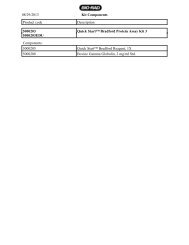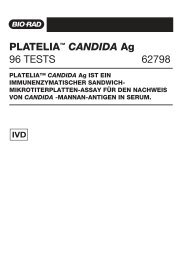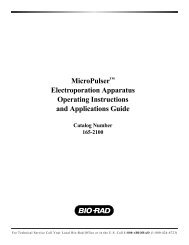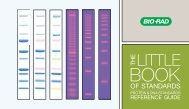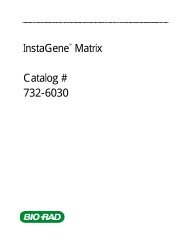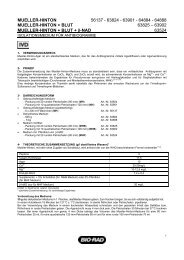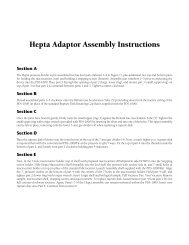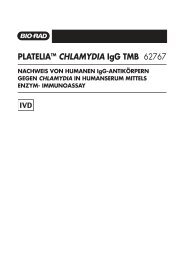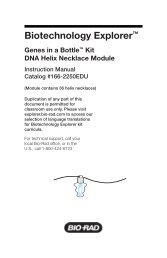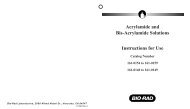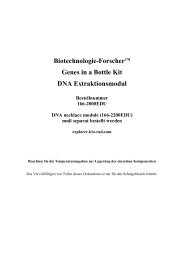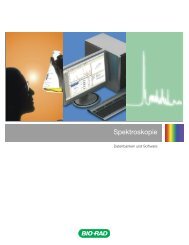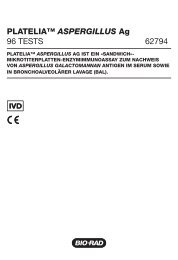Protein Expression and Purification Series - Bio-Rad
Protein Expression and Purification Series - Bio-Rad
Protein Expression and Purification Series - Bio-Rad
Create successful ePaper yourself
Turn your PDF publications into a flip-book with our unique Google optimized e-Paper software.
<strong>Protein</strong> <strong>Expression</strong> <strong>and</strong> <strong>Purification</strong> <strong>Series</strong><br />
Figure 8.28. Typical trace of purification of GST-DHFR-His. The left axis has been set to a maximum value of 2.00 AU <strong>and</strong> the<br />
right axis is set to a maximum value of 50 mS/cm. Trace 1 is the UV trace. It increases after the sample has been loaded, <strong>and</strong> all<br />
proteins that do not bind (the flowthrough) flow past the column <strong>and</strong> through the detectors. The UV curve then decreases to baseline<br />
(close to 0.0) as the column is washed, <strong>and</strong> all non-binding proteins are washed off. The % Buffer B can be seen by looking at<br />
curve 3. Once % Buffer B goes to 100%, the UV curve increases again as the GST-DHFR-His elutes. The UV curve then decreases<br />
as all of the GST-DHFR-His washes off but does not drop to baseline due to the 250 mM imidazole in 100% Buffer B absorbing at<br />
280 nm. Finally, when % Buffer B drops to zero, the UV curve drops back to baseline values. Curve 2 is the conductivity plot. The<br />
conductivity drops slightly when the flowthrough passes through the conductivity detector. Once all the non-binding protein passes,<br />
the conductivity goes back to its initial set point. Once % Buffer B increases to 100%, the conductivity increases slightly due to the<br />
presence of 250 mM imidazole <strong>and</strong> then drops back to its baseline when % Buffer B goes to 0%.<br />
bottom right of the status bar.<br />
8. Figure 8.28 shows a typical chromatogram for this separation.<br />
9.<br />
Label your fractions numerically (1, 2, 3, etc.) making sure to follow the serpentine path that the<br />
fraction collector used.<br />
Note: The <strong>Bio</strong>Frac fraction collector automatically skips tube 1. Tube 2 will be the first one with liquid<br />
in it.<br />
10. Cover your fractions with Parafilm <strong>and</strong> store at 4°C until you are ready to desalt <strong>and</strong> analyze them via<br />
SDS-PAGE <strong>and</strong> enzyme activity.<br />
Cleaning the <strong>Bio</strong>Logic DuoFlow System After Use<br />
In order to keep any instrument in good running form, it is critical to perform certain tasks to make sure<br />
that the instrument is clean <strong>and</strong> ready for use by the next person. For the <strong>Bio</strong>Logic DuoFlow system, it is<br />
important to remove all salt-containing solutions from the lines <strong>and</strong> all bacterial lysate components. The<br />
salts can precipitate out over time clogging fittings, tubing, <strong>and</strong> flow cells. Bacterial lysates can degrade<br />
resulting in growth of molds <strong>and</strong> mildews that also will contaminate <strong>and</strong> clog fittings, tubing, <strong>and</strong> flow cells.<br />
1.<br />
2.<br />
3.<br />
4.<br />
5.<br />
Remove your column but leave the red adaptor fittings attached to the instrument fittings.<br />
Place the luer lock closure column fittings on the inlet <strong>and</strong> outlet of the column to keep the column<br />
from drying out when stored.<br />
Connect the column inlet <strong>and</strong> outlet tubing by connecting the two red fittings adaptors still connected<br />
to the tubing.<br />
Place the buffer A <strong>and</strong> buffer B inlet lines into a beaker containing 200 ml of high-quality water.<br />
In manual mode, make sure that the AVR7-3 valve is in the Load (L) position.<br />
Chapter 8: <strong>Purification</strong> Protocol for <strong>Bio</strong>Logic DuoFlow System<br />
185<br />
CHAPTER 8<br />
BIOLOGIC DUOFLOW<br />
PROTOCOL



